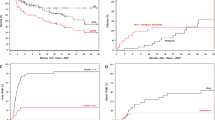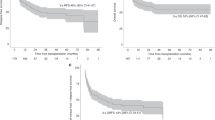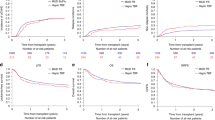Abstract
Patients with high-risk or advanced myeloid malignancies have limited effective treatment options. These include high-dose therapy followed by allogeneic hematopoietic cell transplantation (HCT). We report a single-institution, long-term follow-up of 96 patients, median age 50 (range, 20–60) years, who received HLA-matched related HCT between 1992 and 2007. All patients were treated with a uniform preparatory regimen intended to enhance the widely used regimen of BU and CY that included: BU 16.0 mg/kg (days −8 to −5), etoposide 60 mg/kg (day −4), CY 60 mg/kg (day −2) with GVHD prophylaxis of CsA or FK506 and prednisone. Disease status at transplantation was high-risk AML (n=41), CML in second chronic phase or blast crisis (n=8), myelofibrosis and myeloproliferative disorders (n=8), and myelodysplasia (n=39). Thirty-six percent (n=35) of patients received BM whereas 64% (n=61) received G-CSF-mobilized PBPC. With a median follow-up of 5.6 years (range, 1.6–14.6 years) actuarial 5-year OS was 32% (95% CI 22–42) and 5-year EFS was 31% (95% CI 21–41). Relapse rate was 24% (95% CI 15–33) at 2 and 5 years. Nonrelapse mortality was 29% (95% CI 20–38) at day 100 and 38% (95% CI 29–47) at 1 year. Cumulative incidence of acute (grade II–IV) and extensive chronic GVHD was 27% (95% CI 18–36) and 29% (95% CI 18–40), respectively. There was no statistically significant difference in OS (31 vs 32%, P=0.89) or relapse rates (17 vs 28%, P=0.22) for recipients of BM vs PBPC, respectively. These results confirm that patients with high-risk or advanced myeloid malignancies can achieve long-term survival following myeloablative allogeneic HCT with aggressive conditioning.
This is a preview of subscription content, access via your institution
Access options
Subscribe to this journal
Receive 12 print issues and online access
$259.00 per year
only $21.58 per issue
Buy this article
- Purchase on Springer Link
- Instant access to full article PDF
Prices may be subject to local taxes which are calculated during checkout



Similar content being viewed by others
References
Fung HC, Stein A, Slovak M, O’Donnell MR, Snyder DS, Cohen S et al. A long-term follow-up report on allogeneic stem cell transplantation for patients with primary refractory acute myelogenous leukemia: impact of cytogenetic characteristics on transplantation outcome. Biol Blood Marrow Transplant 2003; 9: 766–771.
Appelbaum FR, Clift RA, Buckner CD, Stewart P, Storb R, Sullivan KM et al. Allogeneic marrow transplantation for acute nonlymphoblastic leukemia after first relapse. Blood 1983; 61: 949–953.
Gale RP, Horowitz MM, Rees JK, Gray RG, Oken MM, Estey EH et al. Chemotherapy versus transplants for acute myelogenous leukemia in second remission. Leukemia 1996; 10: 13–19.
Kebriaei P, Kline J, Stock W, Kasza K, Le Beau MM, Larson RA et al. Impact of disease burden at time of allogeneic stem cell transplantation in adults with acute myeloid leukemia and myelodysplastic syndromes. Bone Marrow Transplant 2005; 35: 965–970.
Wong R, Shahjahan M, Wang X, Thall PF, De Lima M, Khouri I et al. Prognostic factors for outcomes of patients with refractory or relapsed acute myelogenous leukemia or myelodysplastic syndromes undergoing allogeneic progenitor cell transplantation. Biol Blood Marrow Transplant 2005; 11: 108–114.
Yanada M, Emi N, Naoe T, Sakamaki H, Iseki T, Hirabayashi N et al. Allogeneic myeloablative transplantation for patients aged 50 years and over. Bone Marrow Transplant 2004; 34: 29–35.
Blume KG, Kopecky KJ, Henslee-Downey JP, Forman SJ, Stiff PJ, LeMaistre CF et al. A prospective randomized comparison of total body irradiation-etoposide versus busulfan-cyclophosphamide as preparatory regimens for bone marrow transplantation in patients with leukemia who were not in first remission: a Southwest Oncology Group study. Blood 1993; 81: 2187–2193.
Zander AR, Berger C, Kroger N, Stockshlader M, Kruger W, Horstmann M et al. High dose chemotherapy with busulfan, cyclophosphamide, and etoposide as conditioning regimen for allogeneic bone marrow transplantation for patients with acute myeloid leukemia in first complete remission. Clin Cancer Res 1997; 3 (12 Part 2): 2671–2675.
Kroger N, Zabelina T, Sonnenberg S, Kruger W, Renges H, Stute N et al. Dose-dependent effect of etoposide in combination with busulfan plus cyclophosphamide as conditioning for stem cell transplantation in patients with acute myeloid leukemia. Bone Marrow Transplant 2000; 26: 711–716.
Slovak ML, Kopecky KJ, Cassileth PA, Harrington DH, Theil KS, Mohamed A et al. Karyotypic analysis predicts outcome of preremission and postremission therapy in adult acute myeloid leukemia: a Southwest Oncology Group/Eastern Cooperative Oncology Group Study. Blood 2000; 96: 4075–4083.
Greenberg P, Cox C, LeBeau MM, Fenaux P, Morel P, Sanz G et al. International scoring system for evaluating prognosis in myelodysplastic syndromes. Blood 1997; 89: 2079–2088.
Thomas ED, Storb R . Technique for human marrow grafting. Blood 1970; 36: 507–515.
Law LY, Horning SJ, Wong RM, Johnston LJ, Laport GG, Lowsky R et al. High-dose carmustine, etoposide, and cyclophosphamide followed by allogeneic hematopoietic cell transplantation for non-Hodgkin lymphoma. Biol Blood Marrow Transplant 2006; 12: 703–711.
Fraser GA, Walker II . Cytomegalovirus prophylaxis and treatment after hematopoietic stem cell transplantation in Canada: a description of current practices and comparison with Centers for Disease Control/Infectious Diseases Society of America/American Society for Blood and Marrow Transplantation guideline recommendations. Biol Blood Marrow Transplant 2004; 10: 287–297.
Bearman SI, Appelbaum FR, Buckner CD, Petersen FB, Fisher LD, Clift RA et al. Regimen-related toxicity in patients undergoing bone marrow transplantation. J Clin Oncol 1988; 6: 1562–1568.
Glucksberg H, Storb R, Fefer A, Buckner CD, Neiman PE, Clift RA et al. Clinical manifestations of graft-versus-host disease in human recipients of marrow from HL-A-matched sibling donors. Transplantation 1974; 18: 295–304.
Shulman HM, Sullivan KM, Weiden PL, McDonald GB, Striker GE, Sale GE et al. Chronic graft-versus-host syndrome in man. A long-term clinicopathologic study of 20 Seattle patients. Am J Med 1980; 69: 204–217.
Sullivan KM, Shulman HM, Storb R, Weiden PL, Witherspoon RP, McDonald GB et al. Chronic graft-versus-host disease in 52 patients: adverse natural course and successful treatment with combination immunosuppression. Blood 1981; 57: 267–276.
Vigorito AC, Campregher PV, Storer BE, Carpenter PA, Moravec CK, Kiem HP et al. Evaluation of NIH consensus criteria for classification of late acute and chronic GVHD. Blood 2009; 114: 702–708.
Sohn SK, Kim DH, Kim JG, Lee NY, Suh JS, Lee KS et al. Transplantation outcome in allogeneic PBSCT patients according to a new chronic GVHD grading system, including extensive skin involvement, thrombocytopenia, and progressive-type onset. Bone Marrow Transplant 2004; 34: 63–68.
Filipovich AH, Weisdorf D, Pavletic S, Socie G, Wingard JR, Lee SJ et al. National Institutes of Health consensus development project on criteria for clinical trials in chronic graft-versus-host disease: I. Diagnosis and staging working group report. Biol Blood Marrow Transplant 2005; 11: 945–956.
Tauro S, Craddock C, Peggs K, Begum G, Mahendra P, Cook G et al. Allogeneic stem-cell transplantation using a reduced-intensity conditioning regimen has the capacity to produce durable remissions and long-term disease-free survival in patients with high-risk acute myeloid leukemia and myelodysplasia. J Clin Oncol 2005; 23: 9387–9393.
Drobyski WR . The role of allogeneic transplantation in high-risk acute myelogenous leukemia. Leukemia 2004; 18: 1565–1568.
Socie G, Clift RA, Blaise D, Devergie A, Ringden O, Martin PJ et al. Busulfan plus cyclophosphamide compared with total-body irradiation plus cyclophosphamide before marrow transplantation for myeloid leukemia: long-term follow-up of 4 randomized studies. Blood 2001; 98: 3569–3574.
Russell JA, Savoie ML, Balogh A, Turner AR, Larratt L, Chaudhry MA et al. Allogeneic transplantation for adult acute leukemia in first and second remission with a novel regimen incorporating daily intravenous busulfan, fludarabine, 400 cGy total-body irradiation, and thymoglobulin. Biol Blood Marrow Transplant 2007; 13: 814–821.
Shimoni A, Hardan I, Shem-Tov N, Rand A, Yerushalmi R, Nagler A . Fludarabine and treosulfan: a novel modified myeloablative regimen for allogeneic hematopoietic stem-cell transplantation with effective antileukemia activity in patients with acute myeloid leukemia and myelodysplastic syndromes. Leuk Lymphoma 2007; 48: 2352–2359.
Farag SS, Bolwell BJ, Elder PJ, Kalaycio M, Lin T, Pohlman B et al. High-dose busulfan, cyclophosphamide, and etoposide does not improve outcome of allogeneic stem cell transplantation compared to BuCy2 in patients with acute myeloid leukemia. Bone Marrow Transplant 2005; 35: 653–661.
Appelbaum FR, Anderson J . Allogeneic bone marrow transplantation for myelodysplastic syndrome: outcomes analysis according to IPSS score. Leukemia 1998; 12 (Suppl 1): S25–S29.
Armand P, Kim HT, Cutler CS, Ho VT, Koreth J, Ritz J et al. A prognostic score for patients with acute leukemia or myelodysplastic syndromes undergoing allogeneic stem cell transplantation. Biol Blood Marrow Transplant 2008; 14: 28–35.
Cutler C, Giri S, Jeyapalan S, Paniagua D, Viswanathan A, Antin JH . Acute and chronic graft-versus-host disease after allogeneic peripheral-blood stem-cell and bone marrow transplantation: a meta-analysis. J Clin Oncol 2001; 19: 3685–3691.
Sohn SK, Kim DH, Kim JG, Sung WJ, Baek JH, Lee NY et al. Outcome of allogeneic peripheral blood stem cell transplantation using matched sibling donors in patients with high-risk hematological diseases. Eur J Haematol 2004; 72: 430–436.
Guardiola P, Runde V, Bacigalupo A, Ruutu T, Locatelli F, Boogaerts MA et al. Retrospective comparison of bone marrow and granulocyte colony-stimulating factor-mobilized peripheral blood progenitor cells for allogeneic stem cell transplantation using HLA identical sibling donors in myelodysplastic syndromes. Blood 2002; 99: 4370–4378.
del Canizo MC, Martinez C, Conde E, Vallejo C, Brunet S, Sanz G et al. Peripheral blood is safer than bone marrow as a source of hematopoietic progenitors in patients with myelodysplastic syndromes who receive an allogeneic transplantation. Results from the Spanish registry. Bone Marrow Transplant 2003; 32: 987–992.
Brown RA, Wolff SN, Fay JW, Pineiro L, Collins Jr RH, Lynch JP et al. High-dose etoposide, cyclophosphamide, and total body irradiation with allogeneic bone marrow transplantation for patients with acute myeloid leukemia in untreated first relapse: a study by the North American Marrow Transplant Group. Blood 1995; 85: 1391–1395.
Martino R, Valcarcel D, Brunet S, Sureda A, Sierra J . Comparable non-relapse mortality and survival after HLA-identical sibling blood stem cell transplantation with reduced or conventional-intensity preparative regimens for high-risk myelodysplasia or acute myeloid leukemia in first remission. Bone Marrow Transplant 2008; 41: 33–38.
Tallman MS, Dewald GW, Gandham S, Logan BR, Keating A, Lazarus HM et al. Impact of cytogenetics on outcome of matched unrelated donor hematopoietic stem cell transplantation for acute myeloid leukemia in first or second complete remission. Blood 2007; 110: 409–417.
Author information
Authors and Affiliations
Corresponding author
Ethics declarations
Competing interests
The authors declare no conflict of interest.
Rights and permissions
About this article
Cite this article
Naik, S., Wong, R., Arai, S. et al. Long-term outcomes in patients with high-risk myeloid malignancies following matched related donor hematopoietic cell transplantation with myeloablative conditioning of BU, etoposide and CY. Bone Marrow Transplant 46, 192–199 (2011). https://doi.org/10.1038/bmt.2010.114
Received:
Revised:
Accepted:
Published:
Issue Date:
DOI: https://doi.org/10.1038/bmt.2010.114
Keywords
This article is cited by
-
Allogeneic hematopoietic cell transplant for normal karyotype AML: indirect evidence of selection for adverse molecular profile
Bone Marrow Transplantation (2015)
-
Pretransplantation use of the second-generation tyrosine kinase inhibitors has no negative impact on the HCT outcome
Annals of Hematology (2015)
-
Allo-SCT using BU, CY and melphalan for children with AML in second CR
Bone Marrow Transplantation (2013)
-
Sirolimus and mycophenolate mofetil as GVHD prophylaxis in myeloablative, matched-related donor hematopoietic cell transplantation
Bone Marrow Transplantation (2012)
-
Donor compatibility and performance status affect outcome of allogeneic haematopoietic stem cell transplant in patients with relapsed or refractory acute myeloid leukaemia
Annals of Hematology (2012)



